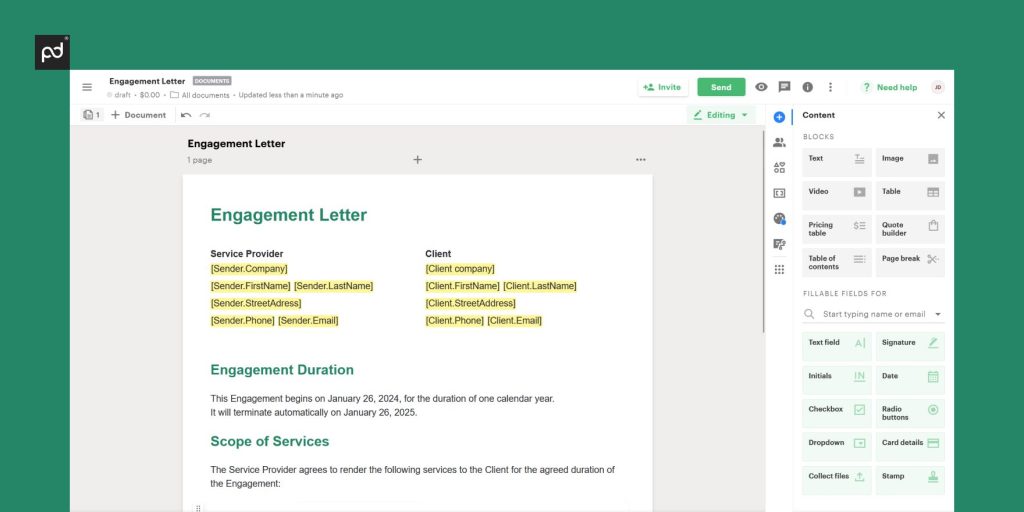
If you’re a provider of professional services, engagement letters are essential—not just to set the terms of the client relationship, but to protect you from litigation.
For example: in 53% of all claims asserted against CPA (Certified Professional Accountant) firms in 2021, there was no related engagement letter.
In this post, we’ll share our guide to engagement letters and show you how to write one.
An engagement letter is a written document that establishes a business relationship between a client and a provider of professional services—usually financial, legal, or consultancy.
It’s a brief but specific description of the relationship, including terms and conditions, scope of work, and fees.
Simpler than a formal contract, it’s still a legal document that protects the interests of both parties.
It helps service providers manage client expectations by specifying exactly what’s provided, which reduces the risk of confusion or dispute.
We’ll take a look at a sample engagement letter a little later in this post.
Engagement letters are suitable for many types of business.
You can adapt them for all types of professional relationships – from long-term contracts to one-off projects – and all types of clients.
The most common time to use an engagement letter is during the client onboarding process at the start of a new relationship or when starting a new project with an existing client.
It should be drafted, negotiated, and signed before any work begins.
A letter of engagement is similar to a contract in that it sets out the terms of the agreement and outlines obligations for both parties.
Both documents are designed to reduce liability and serve as a written record in a dispute.
However, engagement letters are often shorter and less formal.
In a professional relationship, a written agreement with clearly defined responsibilities makes it more likely that each party will uphold their end of the bargain.
Engagement letters define the specific nature of the services, including what won’t be covered.
Without a written record, either party could decide to change the terms.
Written agreements also avoid misunderstandings.
If the terms aren’t clear, the client may mistakenly think they’re entitled to additional services, or the service provider may rely on a payment that doesn’t appear as expected.
As well as marking the official start of a relationship, engagement letters also give both sides a way to end it.
They usually include a termination clause allowing either party to exit under certain conditions.
Engagement letters are legal documents and as such, they are legally binding and can be used in a court of law.
However, it’s important to remember that the document doesn’t become binding until it’s signed by both parties.
The specific Ts & Cs can also affect its enforceability, as can the laws of the relevant country or state.
Here are a few more advantages of using engagement letters.
Scope creep is when a project evolves beyond its original requirements and objectives.
It usually means that one party ends up doing extra work, and it leads to missed deadlines and frustration.
By clearly specifying the scope of work, engagement letters create boundaries to stop this from happening.
Engagement letters also ensure that clients know exactly how much the work will cost, and providers know how much they’ll earn.
They also specify what to do if there are likely to be any additional costs involved.
Both parties can budget accordingly, and nobody gets any nasty surprises.
Transparent communication is essential for client management, and engagement letters provide the groundwork for a positive client experience.
Well-crafted documents demonstrate professionalism and trust and show clients that your services will be equally high in quality.
Since engagement letters are legally binding, they reduce counterparty risk, helping firms avoid litigation.
For individual service providers who don’t have the protection of a large organization, it’s important to reduce liability with a detailed agreement.
Each business and client is different, but this is the classic engagement letter format.

The service provider is responsible for drafting the letter of engagement, often with the help of the company’s legal team or an external lawyer.
Usually, there will be a period of negotiation during which the client may suggest revisions.
Some clients may look for additional legal advice.
In long-term relationships, it’s common to review and update the engagement letter annually.
This reminds the client of the scope and ensures both sides are still happy with the terms.
If the scope of services or anything else changes during the year, the letter must be reissued.
An engagement letter template provides a starting point and ensures documents are standardized—and it’s even better if it’s automated.
Now that we know what to include and why, here’s a typical engagement letter example.
Identification of Parties
Service Provider: ABC Financial Services
[Business address and contact details]
Client: XYZ Manufacturing Ltd
[Business address and contact details]
Engagement Duration
This Engagement begins on January 26, 2024, for the duration of one calendar year. It will terminate automatically on January 26, 2025.
Scope of Services
The Service Provider agrees to render the following services to the Client for the agreed duration of the Engagement:
These services are provided for the Client’s business interests only and not for the Client’s personal finances.
The Client agrees to provide any financial information requested by the Service Provider for the purposes of carrying out the specified services.
The Engagement may be extended with written agreement from both parties in the event of changes to the scope of work.
Payment Terms
The Service Provider will charge a fixed fee of $100 per hour for the agreed services.
The Service Provider will invoice the Client by email on the last day of each month during the Engagement’s duration.
The Client agrees to pay within 10 days of the date shown on each invoice.
Payment details will be provided on each invoice.
The following payment methods are accepted: Bank transfer, Visa, Mastercard, American Express, PayPal, ApplePay.
Confidentiality
Neither party may disclose information about the other party’s finances, business transactions, or performance.
Termination
The Engagement will automatically terminate upon expiry of the agreed duration.
Either party may also terminate the Engagement for the following reasons:
Jurisdiction
This Engagement is governed by and construed in accordance with the laws of [state/country].
Signature and Date
Client Signature ______________________
Service Provider Signature ______________________
The right software lets you create engagement letters that protect both parties and set the tone for your business relationships.
PandaDoc maximizes efficiency with its document workflow software, including ready-to-use templates and drag-and-drop editing for full customization.
Dynamic versions automatically pull client data from your CRM or pre-approved content from the legal team.
Optional content locking guards against omissions and errors.
Both sides can collaborate inside the document, with real-time access to comments, approvals, and version tracking.
Legally binding e-Signatures are built in, making the letter fully digital.
You can store (and organize) engagement letters and other docs in a single online location and receive alerts when they’re due for renewal.
Keep conversations moving with contract management software that works at your speed.
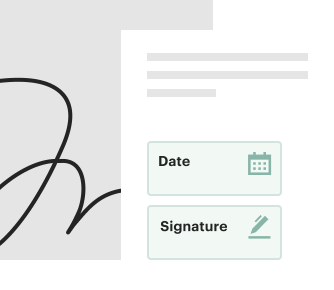
PandaDoc is not a law firm, or a substitute for an attorney or law firm. This page is not intended to and does not provide legal advice. Should you have legal questions on the validity of e-signatures or digital signatures and the enforceability thereof, please consult with an attorney or law firm. Use of PandaDoc services are governed by our Terms of Use and Privacy Policy.
Jenny Pak Director of Program Management at PandaDoc
Jenny Pak is the Director of Program Management at PandaDoc. With 10+ years in the technology sector, she boasts extensive experience in both B2B and B2C SaaS environments. Her expertise encompasses program management, strategic initiatives, experiential marketing, and product launch/campaign management. In her free time she enjoys spending time outdoors with her dog and exploring the city of Los Angeles for the perfect spicy margarita.
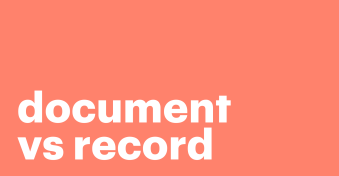
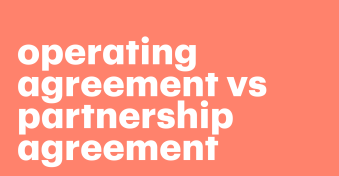
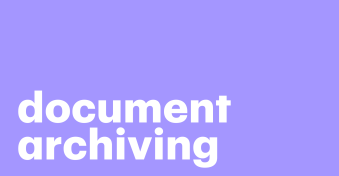
Subscribe to get our most-popular proposal eBook and more top revenue content to help you send docs faster.